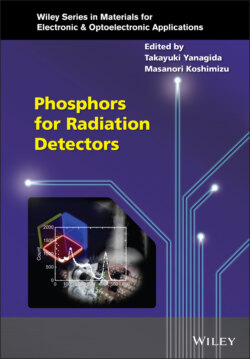Читать книгу Phosphors for Radiation Detectors - Группа авторов - Страница 14
1.1 Introduction
ОглавлениеIonizing radiation was discovered more than one hundred years ago [1]. Ionizing radiation is defined as high energy quanta that ionize materials. For some years, the physical properties, and the uses and harmful effects of ionizing radiation, have been widely recognized. A typical property is its high penetration of materials, especially with high energy photons such as X‐ and γ‐rays. Such properties makes it possible for us to investigate the inside of materials, including the human body, without damaging any of the internal structures. On the other hand, if the human body absorbs too much ionizing radiation, the radiation can cause harm such as a cancer. In order to merit the use of ionizing radiation, control of the amount and energy generated is necessary, for which accurate detection techniques are required. Ionizing radiation is invisible and odorless, and in order to detect it, we must first convert it into something which we can easily access. In most cases, we can use various tools to convert ionizing radiation into a current. From this current, we can easily gain the information desired by using common electronics. Here, the tools used to convert ionizing radiation into recognizable information are known as radiation detectors.
Figure 1.1 illustrates the classification of typical ionizing radiation detectors. Mainly, there are two types of solid materials that are most commonly used as radiation detectors. One is the semiconductor, and the other is in the form of luminescent materials known as scintillators and storage phosphors [2]. The former functions to absorb the energy of the ionizing radiation and converts it into a large number of carriers. The latter converts the ionizing radiation into a large number of photons, which can be detected by photodetectors such as the photomultiplier tube (PMT) and the photodiode (PD). The number of these carriers or photons is proportional to the quantity or energy of the incident ionizing radiation, and in this way, we can measure any type of ionizing radiation. Radiation detector types comprise two kinds of detection methodologies; photon counting‐type and integration‐type. In the photon counting‐type detectors, because each radiation signal is processed event‐by‐event, a fast time‐response typically in the order of ns to μs is important. In contrast, the integration‐type detectors detect multiple events over a few ms, so a fast time‐response is not required. If the counting rate of the target radiation is limited, we generally use the photon counting‐type detectors, while we select the integration‐type when the rate is high.
Figure 1.1 Classification of solid state ionizing radiation detectors.
Semiconductors and scintillators can be applied to both types of detectors, while storage phosphors can only be applied to the integration‐type detectors with a very long integration time (e.g., several weeks to months). These storage phosphors are mainly used for personnel protection dosimetry and imaging plates in the nondestructive study of humans (e.g., dental application) or objects. The storage phosphors used for such applications are mainly classified into three types by emission mechanisms, namely optically stimulated luminescence (OSL) [3], thermally stimulated luminescence (TSL) [4], and radiophotoluminescence (RPL) [5] materials. Hereafter, the two kinds of luminescent materials (scintillators and storage phosphors) are focused. Although the emission mechanisms of storage phosphors are different from those of scintillators, the readout system of dosimeters is similar to that of scintillation detectors. Their emissions are typically read out by PMT under photo‐ or thermal‐stimulation (excitation). Details are described in later chapters.
Typically, luminescent materials for ionizing radiation measurements consist of the host material and the dopant for luminescence centers. For example, Tl‐doped NaI is the most common scintillator [6], NaI is the host which is generally an insulator or semiconductor, and Tl is the dopant with a typically very low concentration. In these kind of materials, the host has a role to absorb the target ionizing radiation efficiently, and the dopant has a role to emit photons whose number is proportional to the incident radiation energy or amount. The combination of the host and the dopant is one of the more recent trends of R&D in this field. The same trend is true, not only for scintillators, but also for storage phosphors for dosimeters.
In addition to host‐dopant type materials, undoped materials have also been investigated for the measurement of radiation. Although we can control the detection properties of luminescent materials by doping, some difficulties in the synthesis, such as a uniformity of dopant distribution, are always problematic. To avoid such problems, continuous effort has been paid to the study of undoped materials. The most common undoped materials for radiation measurement are semiconductor scintillators, and in addition to these, self‐activated scintillators such as Bi4Ge3O12 (BGO) [7] and Auger‐free luminescence (AFL) scintillators (e.g., BaF2 [8]) are also common. Undoped materials have been also investigated for dosimeter applications, and a common material used is BeO [9].
